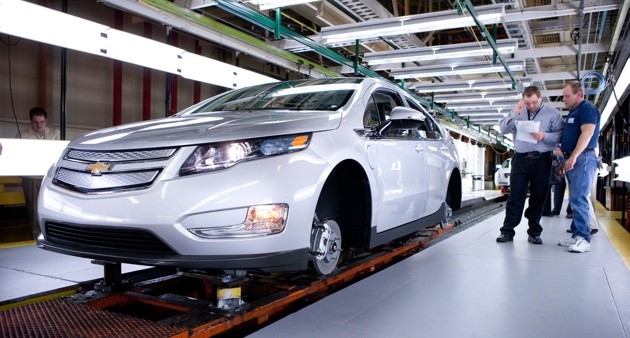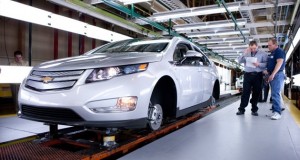News
Should Tesla Take Ford and GM’s “Tesla-beater” Seriously?

Ford and GM have claimed they could build a Tesla-beater as of late, but whether this holds any merit or something to be scoffed at remains to be seen.
Ford Tesla-beater Threat
Although we can theoretically see this happening much further down the road, as battery technology matures and EVs as a whole become the norm, the reality is still not that clear. Ford has certainly shown in the past that it can be a competitive threat when they pour enough money into an endeavor. Such is the case in the early 1960’s when Ford beat its Ferrari rivalry with the legendary GT40. However, a mass-production, consumer viable EV with long range capabilities is exponentially more difficult to execute on – something Elon Musk has long said.

Ford Focus Electric (Photo credit: Ford Motor Company)
Ford’s ‘Power of Choice’ strategy was designed to give consumers a choice of powertrain ranging from gasoline engines, hybrids, plug-in hybrids, and full battery electric vehicles. Unfortunately, the only battery electric vehicle Ford offers is the Focus Electric. As to deciphering Ford’s Tesla-beater claim, the devil is in the details. Ford claims it is capable of making a bigger electric sedan than the Focus Electric. Ford Motor Company CEO, Mark Fields speaks about the Tesla Model S: “We drove it. We took it apart. We put it back together and we drove it again.” Ford could feasibly use the Fusion global platform and turn it into an EV. The problem lies not in the platform, but in the choice of battery and assembly.
Can GM Deliver a Tesla Model III-beater?
 GM has also come out to boldly claim that it can offer Tesla a competitor for the upcoming Model III, according to HybridCars. Reportedly, a 2016 $30,000 range-extended GM car will benefit from improved batteries through lessons learned from its Voltec platform. But bare in mind that GM just revealed its much improved next-generation Volt will sport a larger gasoline powered onboard generator. Did you catch it? GM’s Tesla-beater is an extended range electric plug-in hybrid (PHEV). GM feels Tesla’s well educated EV buyers might be swayed with a PHEV, but we feel this would be better competition for the BMW i3 Rex, extended range EV than a battery electric Tesla. C’mon guys, let’s compare apples to apples.
GM has also come out to boldly claim that it can offer Tesla a competitor for the upcoming Model III, according to HybridCars. Reportedly, a 2016 $30,000 range-extended GM car will benefit from improved batteries through lessons learned from its Voltec platform. But bare in mind that GM just revealed its much improved next-generation Volt will sport a larger gasoline powered onboard generator. Did you catch it? GM’s Tesla-beater is an extended range electric plug-in hybrid (PHEV). GM feels Tesla’s well educated EV buyers might be swayed with a PHEV, but we feel this would be better competition for the BMW i3 Rex, extended range EV than a battery electric Tesla. C’mon guys, let’s compare apples to apples.
GM and Ford Versus the Tesla Motors Philosophy
It is this type of news that keeps us writers writing, but the real comparison is not in powertrain platforms, but in design philosophies. Tesla designed its Model S completely in-house, with very little outsourcing, including the battery pack assembly. Detroit carmakers design their platforms and outsource most parts. Carmakers still treat battery assembly and the final pack as an outsourced commodity, unlike Tesla Motors. That is the crucial difference.
At this stage, the famous Gandhi quote comes to mind: “First they ignore you, then they laugh at you, then they fight you, then you win.” Whether Ford and GM can offer a Tesla-beater besides saying they are capable remains to be seen beyond quotes.

Elon Musk
Starlink passes 9 million active customers just weeks after hitting 8 million
The milestone highlights the accelerating growth of Starlink, which has now been adding over 20,000 new users per day.

SpaceX’s Starlink satellite internet service has continued its rapid global expansion, surpassing 9 million active customers just weeks after crossing the 8 million mark.
The milestone highlights the accelerating growth of Starlink, which has now been adding over 20,000 new users per day.
9 million customers
In a post on X, SpaceX stated that Starlink now serves over 9 million active users across 155 countries, territories, and markets. The company reached 8 million customers in early November, meaning it added roughly 1 million subscribers in under seven weeks, or about 21,275 new users on average per day.
“Starlink is connecting more than 9M active customers with high-speed internet across 155 countries, territories, and many other markets,” Starlink wrote in a post on its official X account. SpaceX President Gwynne Shotwell also celebrated the milestone on X. “A huge thank you to all of our customers and congrats to the Starlink team for such an incredible product,” she wrote.
That growth rate reflects both rising demand for broadband in underserved regions and Starlink’s expanding satellite constellation, which now includes more than 9,000 low-Earth-orbit satellites designed to deliver high-speed, low-latency internet worldwide.
Starlink’s momentum
Starlink’s momentum has been building up. SpaceX reported 4.6 million Starlink customers in December 2024, followed by 7 million by August 2025, and 8 million customers in November. Independent data also suggests Starlink usage is rising sharply, with Cloudflare reporting that global web traffic from Starlink users more than doubled in 2025, as noted in an Insider report.
Starlink’s momentum is increasingly tied to SpaceX’s broader financial outlook. Elon Musk has said the satellite network is “by far” the company’s largest revenue driver, and reports suggest SpaceX may be positioning itself for an initial public offering as soon as next year, with valuations estimated as high as $1.5 trillion. Musk has also suggested in the past that Starlink could have its own IPO in the future.
News
NVIDIA Director of Robotics: Tesla FSD v14 is the first AI to pass the “Physical Turing Test”
After testing FSD v14, Fan stated that his experience with FSD felt magical at first, but it soon started to feel like a routine.

NVIDIA Director of Robotics Jim Fan has praised Tesla’s Full Self-Driving (Supervised) v14 as the first AI to pass what he described as a “Physical Turing Test.”
After testing FSD v14, Fan stated that his experience with FSD felt magical at first, but it soon started to feel like a routine. And just like smartphones today, removing it now would “actively hurt.”
Jim Fan’s hands-on FSD v14 impressions
Fan, a leading researcher in embodied AI who is currently solving Physical AI at NVIDIA and spearheading the company’s Project GR00T initiative, noted that he actually was late to the Tesla game. He was, however, one of the first to try out FSD v14.
“I was very late to own a Tesla but among the earliest to try out FSD v14. It’s perhaps the first time I experience an AI that passes the Physical Turing Test: after a long day at work, you press a button, lay back, and couldn’t tell if a neural net or a human drove you home,” Fan wrote in a post on X.
Fan added: “Despite knowing exactly how robot learning works, I still find it magical watching the steering wheel turn by itself. First it feels surreal, next it becomes routine. Then, like the smartphone, taking it away actively hurts. This is how humanity gets rewired and glued to god-like technologies.”
The Physical Turing Test
The original Turing Test was conceived by Alan Turing in 1950, and it was aimed at determining if a machine could exhibit behavior that is equivalent to or indistinguishable from a human. By focusing on text-based conversations, the original Turing Test set a high bar for natural language processing and machine learning.
This test has been passed by today’s large language models. However, the capability to converse in a humanlike manner is a completely different challenge from performing real-world problem-solving or physical interactions. Thus, Fan introduced the Physical Turing Test, which challenges AI systems to demonstrate intelligence through physical actions.
Based on Fan’s comments, Tesla has demonstrated these intelligent physical actions with FSD v14. Elon Musk agreed with the NVIDIA executive, stating in a post on X that with FSD v14, “you can sense the sentience maturing.” Musk also praised Tesla AI, calling it the best “real-world AI” today.
News
Tesla AI team burns the Christmas midnight oil by releasing FSD v14.2.2.1
The update was released just a day after FSD v14.2.2 started rolling out to customers.

Tesla is burning the midnight oil this Christmas, with the Tesla AI team quietly rolling out Full Self-Driving (Supervised) v14.2.2.1 just a day after FSD v14.2.2 started rolling out to customers.
Tesla owner shares insights on FSD v14.2.2.1
Longtime Tesla owner and FSD tester @BLKMDL3 shared some insights following several drives with FSD v14.2.2.1 in rainy Los Angeles conditions with standing water and faded lane lines. He reported zero steering hesitation or stutter, confident lane changes, and maneuvers executed with precision that evoked the performance of Tesla’s driverless Robotaxis in Austin.
Parking performance impressed, with most spots nailed perfectly, including tight, sharp turns, in single attempts without shaky steering. One minor offset happened only due to another vehicle that was parked over the line, which FSD accommodated by a few extra inches. In rain that typically erases road markings, FSD visualized lanes and turn lines better than humans, positioning itself flawlessly when entering new streets as well.
“Took it up a dark, wet, and twisty canyon road up and down the hill tonight and it went very well as to be expected. Stayed centered in the lane, kept speed well and gives a confidence inspiring steering feel where it handles these curvy roads better than the majority of human drivers,” the Tesla owner wrote in a post on X.
Tesla’s FSD v14.2.2 update
Just a day before FSD v14.2.2.1’s release, Tesla rolled out FSD v14.2.2, which was focused on smoother real-world performance, better obstacle awareness, and precise end-of-trip routing. According to the update’s release notes, FSD v14.2.2 upgrades the vision encoder neural network with higher resolution features, enhancing detection of emergency vehicles, road obstacles, and human gestures.
New Arrival Options also allowed users to select preferred drop-off styles, such as Parking Lot, Street, Driveway, Parking Garage, or Curbside, with the navigation pin automatically adjusting to the ideal spot. Other refinements include pulling over for emergency vehicles, real-time vision-based detours for blocked roads, improved gate and debris handling, and Speed Profiles for customized driving styles.








